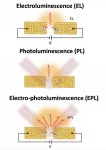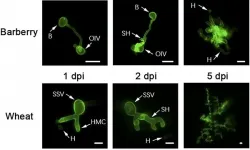(Press-News.org) HOUSTON - (March 18, 2021) - If you're looking for one technique to maximize photon output from plasmons, stop. It takes two to wrangle.
Rice University physicists came across a phenomenon that boosts the light from a nanoscale device more than 1,000 times greater than they anticipated.
When looking at light coming from a plasmonic junction, a microscopic gap between two gold nanowires, there are conditions in which applying optical or electrical energy individually prompted only a modest amount of light emission. Applying both together, however, caused a burst of light that far exceeded the output under either individual stimulus.
The researchers led by Rice physicist Douglas Natelson and lead authors Longji Cui and Yunxuan Zhu found the effect while following up experiments that discovered driving current through the gap increased the number of light-emitting "hot carrier" electrons in the electrodes.
Now they know that adding energy from a laser to the same junction makes it even brighter. The effect could be employed to make nanophotonic switches for computer chips and for advanced photocatalysts.
The details appear in the American Chemical Society journal Nano Letters.
"It's been known for a long time that it's possible to get a light emission from these tiny structures," Natelson said. "In our previous work, we showed that plasmons play an important role in generating very hot charge carriers, equivalent to a couple of thousand degrees."
Plasmons are ripples of charge that carry energy, and when triggered, flow across the surface of certain metals, including gold. In the voltage-driven mechanism, electrons tunnel through the gap, exciting plasmons, which leads to hot electrons recombining with electron "holes" and emitting photons in the process.
Even though the effect seemed dramatic at the time, it paled in comparison to the new discovery.
"I like the idea of '1+1=1,000," Natelson said. "You do two things, each of which doesn't give you much light in this energy range, but together, holy cow! There's a lot of light coming out."
The specific mechanisms are worthy of further study, he said. One possibility is that optical and electrical drives combine to enhance the generation of hot electrons. An alternative is that light emission gets a boost via anti-Stokes electronic Raman scattering. In that process, light input prompts already excited hot carriers to relax back to their ground states, releasing more photons.
"Something interesting is going on there, where each of these individual excitations is not enough to give you the amount of light coming out," Natelson said. "But put them together and the effective temperature is much higher. That's one possible explanation: that the light output is an exponential function of the temperature. Reaching that effective temperature takes hundreds of femtoseconds.
"The Raman mechanism is more subtle, where light comes in, grabs energy from the voltage, and even stronger light leaves," he said. "That happens even faster, so a time-dependent experiment could probably help us figure out the dominant mechanism.
"The reason it's neat is that you can, in principle, couple the electrical drive and light coming in to do all kinds of things," Natelson said. "If the hot carrier picture is right, there's the possibility of doing some interesting chemistry."
Co-authors of the paper are Peter Nordlander, the Wiess Chair in Physics and Astronomy and a professor of electrical and computer engineering and of materials science and nanoengineering at Rice, and Massimiliano Di Ventra, a professor of physics at the University of California, San Diego. Cui, a former postdoctoral fellow at Rice, is now an assistant professor of mechanical engineering and materials science and engineering at the University of Colorado Boulder. Zhu is a graduate student at Rice. Natelson is chair and a professor of physics and astronomy and a professor of electrical and computer engineering and of materials science and nanoengineering.
INFORMATION:
The J. Evans Attwell Welch Fellowship, Rice's Smalley-Curl Institute, the Robert A. Welch Foundation, the University of Colorado and the National Science Foundation supported the research.
Read the abstract at https://pubs.acs.org/doi/10.1021/acs.nanolett.1c00503.
This news release can be found online at https://news.rice.edu/2021/03/18/teamwork-makes-light-shine-ever-brighter/.
Follow Rice News and Media Relations via Twitter @RiceUNews.
Related materials:
Rice lab's bright idea is pure gold: http://news.rice.edu/2020/06/29/rice-labs-bright-idea-is-pure-gold-2/
Natelson Research Group: https://natelson.web.rice.edu/group.html
Longji Cui: https://www.colorado.edu/mechanical/longji-cui
Nordlander Nanophotonics Group: http://nordlander.rice.edu
Massimiliano Di Ventra: https://diventra.physics.ucsd.edu
Rice Department of Physics and Astronomy: https://physics.rice.edu
Wiess School of Natural Sciences: https://naturalsciences.rice.edu
Image for download:
https://news-network.rice.edu/news/files/2021/03/0322_LIGHT-1-WEB.jpg
Electrical current and laser light combine at a gold nanogap to prompt a dramatic burst of light. The phenomenon could be useful for nanophotonic switches in computer chips and for advanced photocatalysts. (Credit: Natelson Research Group/Rice University)
Located on a 300-acre forested campus in Houston, Rice University is consistently ranked among the nation's top 20 universities by U.S. News & World Report. Rice has highly respected schools of Architecture, Business, Continuing Studies, Engineering, Humanities, Music, Natural Sciences and Social Sciences and is home to the Baker Institute for Public Policy. With 3,978 undergraduates and 3,192 graduate students, Rice's undergraduate student-to-faculty ratio is just under 6-to-1. Its residential college system builds close-knit communities and lifelong friendships, just one reason why Rice is ranked No. 1 for lots of race/class interaction and No. 1 for quality of life by the Princeton Review. Rice is also rated as a best value among private universities by Kiplinger's Personal Finance.
Jeff Falk
713-348-6775
jfalk@rice.edu
Mike Williams
713-348-6728
mikewilliams@rice.edu
When it comes to recreational crabbing--one of the most iconic pastimes along Maryland's shores--the current estimate of 8% of "total male commercial harvest" runs just a little too low. Biologists, with local community support, found stronger evidence for the underestimate in the END ...
As one of the founding members of the International Rye Genome Sequencing Group (IRGSG), the University of Maryland (UMD) co-published the first full reference genome sequence for rye in Nature Genetics. UMD and international collaborators saw the need for a reference genome of this robust small grain to allow for the tracking of its useful genes and fulfill its potential for crop improvement across all major varieties of small grains, including wheat, barley, triticale (a cross between wheat and rye that is gaining popularity), and rye. Following the model of international collaboration used ...
Wheat stripe rust is one of the most important wheat diseases and is caused by the plant-pathogenic fungi Puccinia striiformis f. sp. tritici (Pst). Though Pst is known to be highly host-specific, it is interestingly able to infect two unrelated host plants, wheat and barberry, at different spore stages. Pst infects wheat through its urediniospores and infects barberry with its basidiospores.
"This complex life cycle poses interesting questions on the co-evolution between the pathogen and the hosts, as well the different mechanisms of pathogenesis underlying the infection of ...
The Journal of Anthropological Research has just published a new article on the development of linguistic documentation among heritage language speakers: "Articulating Lingual Life Histories and Language Ideological Assemblages: Indigenous Activists within the North Fork Mono and Village of Tewa Communities."
Specifically, it focuses on the biographical information of individual speakers, and the significance they place on the language in question. Author Paul V. Kroskrity focused his research on two specific communities - the North Fork Rancheria of Mono Indians in California and the Village of Tewa, First Mesa, Hopi Reservation in northeastern Arizona ...
In a study aimed at investigating the mechanism responsible for exacerbating rheumatoid arthritis in smokers, researchers at the Center for Research on Inflammatory Diseases (CRID), linked to the University of São Paulo (USP) in Brazil, discovered a novel path in the inflammatory process associated with the bone damage caused by rheumatoid arthritis. The discovery opens up opportunities for new therapeutic interventions to mitigate the effects of the disease, for which there is no specific treatment at this time.
An article on the study is published in Proceedings of the National Academy of Sciences ...
Lung cancer is the leading cause of cancer death in the U.S. for both men and women. While risk for this disease can be influenced by environmental and lifestyle factors like smoking, studies estimate that 18% of lung cancer cases are due to inherited genetic variants. New research led by Baylor College of Medicine investigates how genetic variants contribute to increased risk of lung cancer.
The researchers performed whole exome sequencing on germline (inherited) DNA from eight large-scale datasets, including 1,045 patients with a family history of lung cancer or early-onset cancer. Those groups are more likely to harbor genetic risk variants. The analysis ...
Researchers at the University of Ottawa have debunked the decade-old myth of metals being useless in photonics - the science and technology of light - with their findings, recently published in Nature Communications, expected to lead to many applications in the field of nanophotonics.
"We broke the record for the resonance quality factor (Q-factor) of a periodic array of metal nanoparticles by one order of magnitude compared to previous reports," said senior author Dr. Ksenia Dolgaleva, Canada Research Chair in Integrated Photonics (Tier 2) and ...
Medical cannabis is a subject of much debate. There is still a lot we do not know about cannabis, but researchers from the Department of Neuroscience at the Faculty of Health and Medical Sciences have made a new discovery that may prove vital to future research into and treatment with medical cannabis.
Cannabinoids are compounds found in cannabis and in the central nervous system. Using a mouse model, the researchers have demonstrated that a specific synthetic cannabinoid (cannabinoid WIN55,212-2) reduces essential tremor by activating the support cells of the spinal cord and brain, known as astrocytes. Previous research into medical cannabis has focussed on the ...
LOS ANGELES (March 18, 2021) -- COVID-19 disproportionately affects men compared with women, raising the possibility that a hormone like progesterone may improve clinical outcomes for certain hospitalized men with the disease. New research from Cedars-Sinai published online in the journal Chest supports this hypothesis.
The pilot clinical trial, involving 40 men, is believed to be the first published study to use progesterone to treat male COVID-19 patients whose lung functions have been compromised by the coronavirus. While the findings are promising, larger clinical trials are needed to establish the potential of this experimental therapy, the investigators said.
The study was prompted ...
In response to the recent freeze-inspired power outages in Texas, some politicians blamed the historic blackouts on wind turbines. The dubious, and largely dismissed, claims nevertheless spotlighted an intriguing fact: Texas, the land made famous by oil derricks and wildcatters, now gets a significant portion of its electricity from clean, renewable sources, most notably wind, but also from water and solar - a troika of sustainability known collectively as WWS.
"Texas gets about 20 percent of its electricity from wind alone," says Mark Z. Jacobson, a professor of civil and environmental engineering at Stanford University and senior fellow at the Stanford Woods Institute ...






